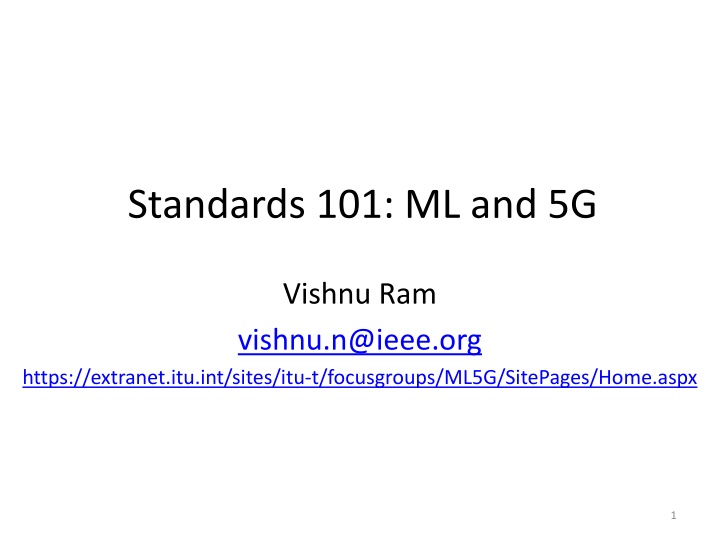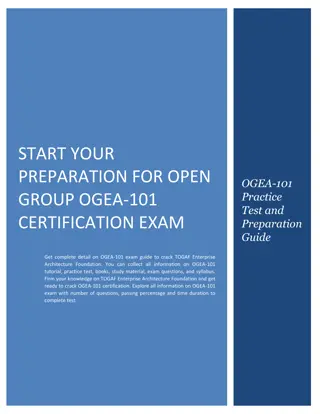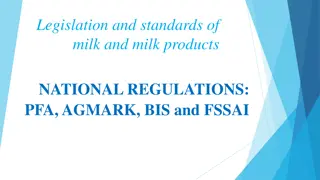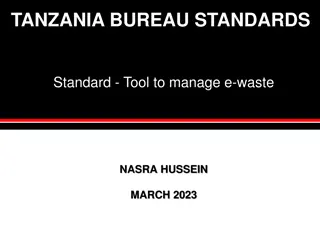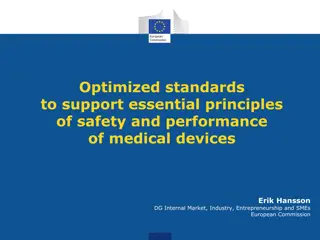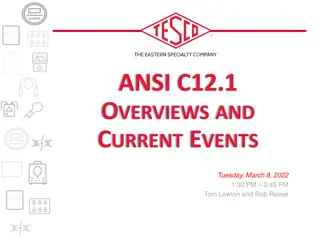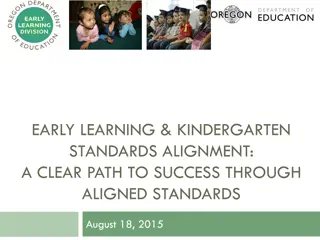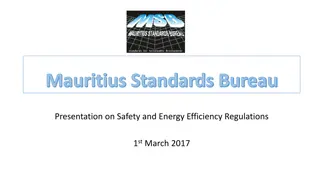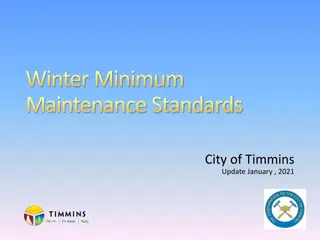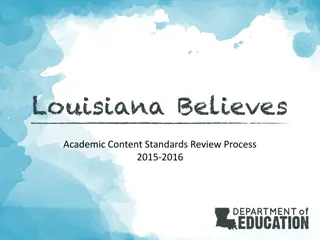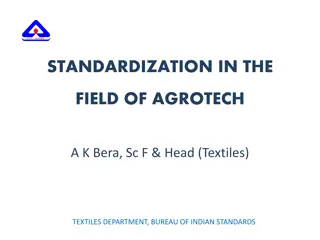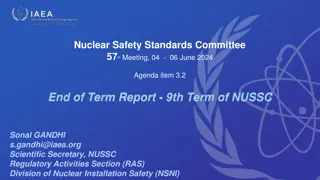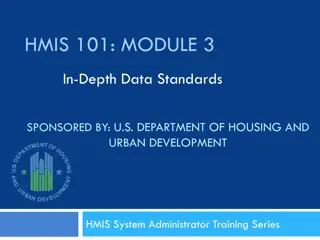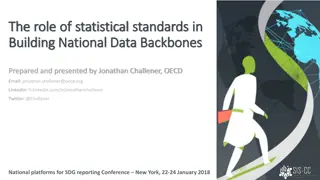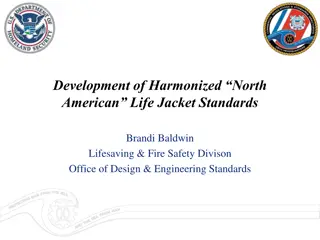Standards 101: ML and 5G
Step-by-step process for contributing to standards in Machine Learning for 5G networks, including stalking technology, engaging with SDOs, understanding work items, fostering collaborations, and aligning timelines for prototypes and optimizations.
Download Presentation

Please find below an Image/Link to download the presentation.
The content on the website is provided AS IS for your information and personal use only. It may not be sold, licensed, or shared on other websites without obtaining consent from the author.If you encounter any issues during the download, it is possible that the publisher has removed the file from their server.
You are allowed to download the files provided on this website for personal or commercial use, subject to the condition that they are used lawfully. All files are the property of their respective owners.
The content on the website is provided AS IS for your information and personal use only. It may not be sold, licensed, or shared on other websites without obtaining consent from the author.
E N D
Presentation Transcript
Standards 101: ML and 5G Vishnu Ram vishnu.n@ieee.org https://extranet.itu.int/sites/itu-t/focusgroups/ML5G/SitePages/Home.aspx 1
Agenda 9 step process for contribution to standards (ITU-T FG ML5G) AIM To utilize the real opportunity for making strong contributions in the use of ML in communication networks. To gain early movers advantage 2
Step-1: Stalk the technology Many use cases for optimization in 5G, Requires highly trained expert knowledge Use mathematical models Use heuristic approaches. Suboptimal solutions Loads of code Enter ML/AI It will solve everything!! It will replace all experts!! The best solutions!! Generalized approach!! Wait a moment!! It doesn t solve everything. We need experts to train AI/ML. GIGO still applies. ML models over-fit in most cases. 3 Emoticons from shutterstock.com, iconfinder.com
Step-2: Stalk the SDO ITU-T focus group Machine Learning for Future Networks including 5G (FG ML5G) was established by ITU-T Study Group 13 at its meeting in Geneva (6-17 November 2017). The 7thmeeting of the ITU-T Focus Group on Machine Learning for Future Networks including 5G (FG ML5G) was held in Berlin, Germany, from 6 to 7 November 2019 Next meeting in March 2020 (China) Weekly conference calls of FG ML5G take place on Wednesdays ITU-T mentors student projects 4
Step-3: Do your homework on the work items 2019 Analyzed use cases for ML in 5G Approved ITU- T Supplement 55 to Y.3170 Need Architecture framework for ML in 5G Published ITU-T Y.3172 Data handling framework for ML in 5G Consented Y.3174 Evaluating intelligence of networks Consented Y.3173 Wait a moment!! It aint distributed. How do we optimize? How do I integrate ML marketplaces? What are the future gaps in standards? 5
Step-4: Love thy neighbour LS are published in ML5G website ETSI ZSM (closed loop) ETSI ENI (Intelligence levels) Open RAN alliance (interfaces) ITU Linux Foundation AI MPEG (ISO/IEC) 3GPP SA5/SA1 IRTF NMRG ITU FG is open for collaborations or LS https://extranet.itu.int/sites/itu-t/focusgroups/ML5G/SitePages/Home.aspx Accessible via guest account for non members of ITU-T 6
Step-5: Align your timelines Ite m Description Timeline Prototypes, NN model optimization techniques, compression mechanisms, architecture representations in 5G 1 Optimization of ML models in distributed architectures July 2020 Monitoring techniques, resource allocation mechanisms, mediation mechanisms, interface APIs with NFVO in 5G 2 Impacts to orchestration for ML July 2020 3 Gap analysis July 2020 Current heuristic models, India specific use cases, Deployment issues, Training mechanisms, Data, etc 7
Step-6: Engage! ITU Global AI Challenge Learn and use ITU standards Propose to use data sets and models from: https://extranet.itu.int/sites/itu- t/focusgroups/ML5G/input/ML5G-I-184.zip Potential partnership with ITU-T for AI challenge Mentorship from ITU Aligned with AI-for-Good summit 8
Step-7: S-killing! ITU offers Student projects ITU is offering guidance to uni students for doing relevant projects in AI/ML in 5G. List of projects is described in ML5G-I-174 How to join: 15-20 students actively contributing at any point of time Across 4-5 countries 6 student contributions published from 4 different countries. Publicly accessible from ITU FG sharepoint site. Send me an email
Step-8: Bust the myths 1. I am a researcher studying the latest variant of CNN, RNN, Deep RL, GNN, xNN. I don t care about standards. 2. I am not be a member of ITU. 3. I am already active in XYZ standards body. 4. I have no travel funds 5. My supervisor/boss wants a contribution by tonight 6. I am into Layer xyz of 5G. I don t see application of ML/AI. 7. I don t know ABCD of ML. I am an expert in e-health, automotive, manufacturing... 8. I want to write an Epic standard, rewrite future technology, solve world hunger, boil the ocean . Talk to the editor 10
Step-9: Cp cat Follow the examples ML5G-I-206.docx The contribution was made on Optimization techniques for ML models in distributed networks 1. The training needs to factor data at the edge. 2. Communication overhead has to be small. 3. Convergence has to be fast. 4. Accuracy cannot be compromised. 5. Edge has less resources. Training, parameter updates Central Cloud Edge-1 Edge-2 Talk to the mentor 11
References [1] Supplement 55 to Y.3170-series: Y.ML-IMT2020-Use-Cases Machine learning in future networks including IMT-2020: use cases (ML5G-I-153-R1) [2] ITU-T Y.3172 (https://www.itu.int/rec/T-REC-Y.3172/en) [3] ITU-T Y.3173 (ML5G-I-151-R5) [4] ITU-T Y.3174 (ML5G-I-148-R3) [5] ML5G-I-167R5 [6] ML5G-I-171R2 [7] ML5G-I-172R2 [8] ML5G-I-174 https://extranet.itu.int/sites/itu-t/focusgroups/ML5G/input/ML5G-I-206.docx https://extranet.itu.int/sites/itu-t/focusgroups/ML5G/input/ML5G-I-201.docx https://extranet.itu.int/sites/itu-t/focusgroups/ML5G/input/ML5G-I-197.docx https://extranet.itu.int/sites/itu-t/focusgroups/ML5G/input/ML5G-I-182.docx https://extranet.itu.int/sites/itu-t/focusgroups/ML5G/input/ML5G-I-173-R1.docx https://extranet.itu.int/sites/itu-t/focusgroups/ML5G/input/ML5G-I-168.docx https://extranet.itu.int/sites/itu-t/focusgroups/ML5G/SitePages/Home.aspx Color legend: Accessible via ITU-T member account Accessible via guest account for non members of ITU-T 12
Thank you! vishnu.n@ieee.org https://extranet.itu.int/sites/itu-t/focusgroups/ML5G/SitePages/Home.aspx
Use case contributions Use cases for ML in IMT-2020 and future networks Use case Classification More than 30 use cases submitted to the FG Requirements were analyzed for each, reviewed and compiled. Requirements are classified as critical , expected and added value . Network slice and service User plane related App related Signaling, mngmt related Security related Requirements Classification Approved by SG13 as supplement [1] Data Storage and processing Application of ML Data Collection
Architecture framework Published by ITU as Y.3172 [2] Provides an environment for test/verify ML ML Sandbox Provides an abstraction for handling ML MLFO ML Pipeline Manage ML functionality in the network E.g. IMT-2020 networks like 3GPP Underlay networks
Consented by SG13 as Y.3174 [4] Data handling framework Provides management of data handling ML marketplace Provides mapping of data models Provides Data broker MLFO API mapping mapping of APIs ML pipeline Underlay networks
ML5G-I-167R5 (last call) [5] ML Marketplace integration A set of 10+ APIs are defined in ML5G-I- 167R5 Provides Model Provides Model Management subsystem selection and management External ML Marketplace search, update, and metadata Other ML Marketplace 12 management and orchestratio n functions 7 MLFO 11 Provides Model Internal ML Marketplace training and optimization 13 14 ML sandbox subsystem ML Sandbox 6 6 MLFO 3 ML pipeline subsystem ML pipeline 5 ML Intent 4 ML underlay networks Underlay networks
Consented by SG13 as Y.3173 [3] MLFO NFVO ML pipeline ML Intent 1. Parse and decide the ML functions for this ML use case Intent based creation of ML pipeline 2. Parse NSD and instantiate NS (using existing methods) Intelligence level evaluation 3. Instantiate ML functions 5. Parse and decide monitoring requirements as defined in the ML intent 4. Instantiate ML functions 6. Monitoring configuration Monitoring of ML pipeline Based on the dimensions 7. Monitoring report [Data collection] 8. Monitoring report [Analysis] 9. Monitoring report [Action implementation] 10. Measure intelligence level Intelligence capability level
MLFO ML5G-I-172 (in progress) [7] Controls the selection, training, optimization, evaluation of ML models. ML Sandbox Data models are no more an open ended problem because the characteristics of the data sources and sinks are known to MLFO. Controls the data handling Controls the deployment of ML pipeline nodes Selection of ML models is no more an open ended problem because the ML model metadata is known to MLFO. Provides declarative ML intent MLFO ML Pipeline Optimization of ML models is no more an open ended problem because training data, model history are known to MLFO. Monitors the ML pipeline nodes, controls maintenance, retraining Interfaces with the NFVO and Management systems Underlay networks
Thank you! vishnu.n@ieee.org https://extranet.itu.int/sites/itu-t/focusgroups/ML5G/SitePages/Home.aspx
